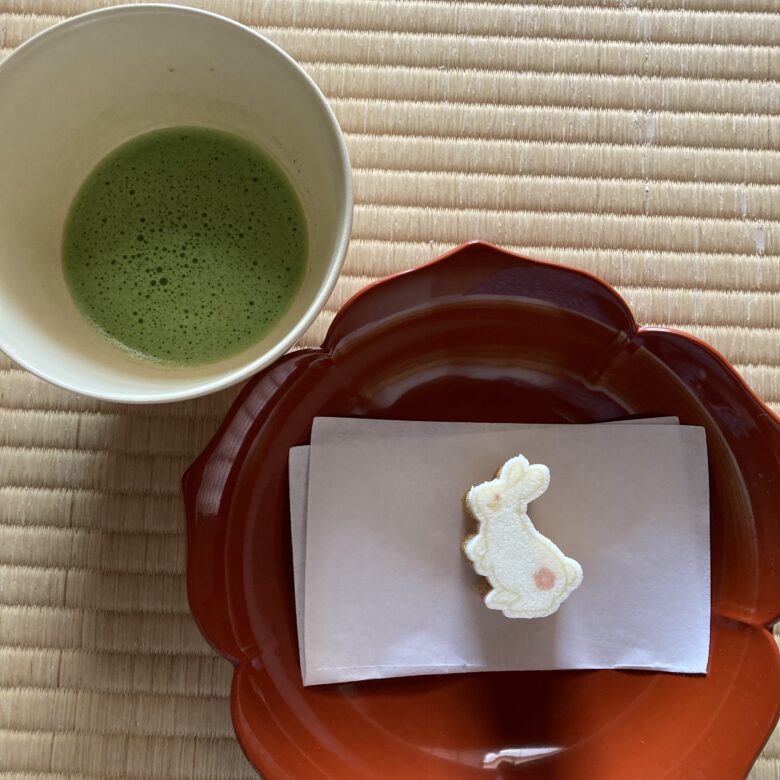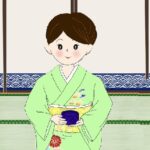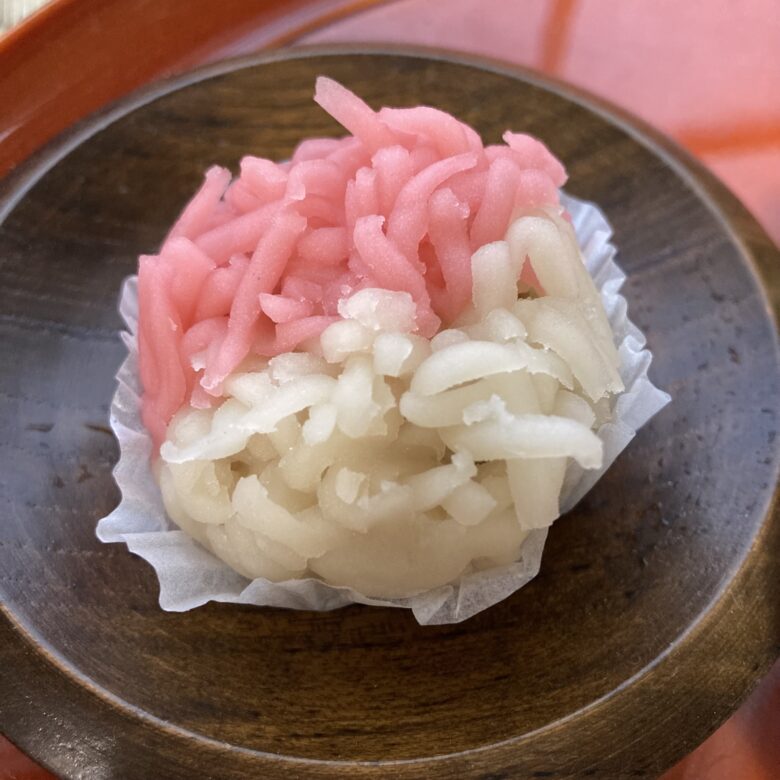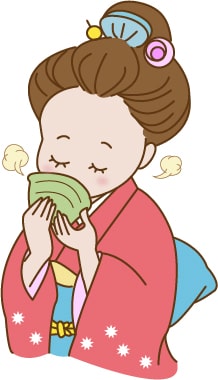PR
英語で茶道について説明してみよう!

英語が達者な方でも茶道について英語で説明してください、と突然言われてスラスラ説明できる日本人は少ないです。それは、日本語でも説明できないからです。
まずは日本人として日本語で茶道に関する知識をつけて欲しいとの想いで、茶道の精神・茶道と禅の関係、千利休の想いが詰まった利休百首などについて解説ページを作成しました。
本記事ではいよいよ外国人に茶道について英語で説明することに関して解説していきます。
この記事を読むとわかること。

⭕️外国人に自信を持って英語で茶道の説明をできるようになる。
⭕️茶道体験にも種類があることがわかる。
⭕️茶道体験を説明する時に必要な英語表現がわかる。
是非この記事を読んで、美味しかったですね、だけで終わらせない茶道体験を海外の人に伝えてください。
茶道体験の種類
茶道体験と一言で言っても単純にお菓子とお抹茶を頂くだけの体験から、茶道の先生がお点前をするのを見てもらってお抹茶を頂く体験、茶道の先生がお点前をするだけでなくゲストにもお茶を点ててもらってお抹茶を頂く体験の3つのスタイルがあります。
茶道体験の種類
・お抹茶体験 (飲むだけ)
・茶室体験 (見る茶道体験)
・茶道体験 (見て体験する茶道体験)
上記の種類の名前は明確な定義はありませんが、便宜上このページでは上の3つ名前をつけています。
どのスタイルの茶道体験なのかによって、説明が必要なことも変わってくるので、海外の方を茶道体験にお連れするときは、お連れする茶道体験がどのタイプなのかを確認しましょう。
通訳案内士のお仕事では、仕事を任せる側の旅行会社の担当の方も違いをわかっておらず、「茶道体験」とだけ言われて依頼されることもあるので、どの種類の体験なのか確認することは大切です。
実際にある英語茶道体験の場所はこちら▶東京の茶道体験英語まとめ
英語茶道で説明すること
どの種類の茶道体験にお連れする場合でもまず茶道とは何かを理解してもらいましょう。
茶道体験は英語では『Tea ceremony experience』と訳されますが『Tea ceremony experience 』にあっている日本語は『茶事』または『茶会』です。実際には茶事をするわけではないので、『Sado experience』が正しいです。
だからといって、『Sado experience』と聞いてピントくる外国人はよっぽどの日本通だと思うので、さわりの段階では『Tea ceremony experience』でよいと思いますが、セレモニーというと儀式や祝典のようなイメージを持つ方もいると思います。
もしお菓子を食べてお抹茶を飲むだけの体験の場合、厳かな儀式が見れると思われていたら拍子抜けしてしまうので、『Tea ceremony experience』の訳にふさわしいお茶事と茶道の違いは説明した方がよいです。
※茶事と茶会の違い
茶事は懐石料理を含むフルコースの会で、少人数で行われる招待制のものです。
茶会は場合によって違いますが、チケットを買えば基本的に誰でも参加できるもので、お茶を飲むだけのものや簡単なお弁当が提供される場合もある、カジュアルな会を指します。「大東京茶会」やお寺や美術館などで開催されるものは茶会になります。
英語茶道 | 茶事(茶会)と茶道の違い
日本で生まれ育っていない海外の人に茶道とは何かを説明する場合、海外の人でもイメージしやすい具体例をあげながら説明すると理解が深まります。
ティーセレモニーとは、抹茶を美味しく頂くためのセレモニーで、本物のティーセレモニーは4時間くらいかかります。フルコースのお料理のあとに2種類の抹茶を飲む儀式です。
茶会とは亭主と客がそれぞれの役割を果たして、双方で作り出すものです。
A tea ceremony is a ceremony to enjoy matcha tea. An authentic tea ceremony takes about four hours. It is a ceremony in which two kinds of matcha are drunk after a full course meal.
A tea ceremony is a gathering where the host and guests each play their roles and create a harmonious atmosphere.
本来のティーセレモニーは、日本の伝統的なティーハウスでコース料理を食べて、日本酒を飲み、いったん休憩をはさんで2種類の抹茶を飲むという流れで、ラグジャリーなレストランで、フルコースのあとにデザートが2種類でてくるのに似ています。
In the original Tea Ceremony, participants would eat a course meal at a traditional Japanese tea house and drink sake (Japanese rice wine). After enjoying the meal, they leave the tea house once and take a break. After the host prepares for preparing matcha, guests enjoy two types of matcha.It is similar to a full course meal followed by two desserts in a luxury restaurant.
ラグジュアリーなレストランではお料理もデザートも両方が主役ですが、ティーセレモニーでは主役はお抹茶です。お抹茶を美味しくいただくためにあるのがお料理であり、お菓子です。お料理とお菓子はあくまでお抹茶の美味しさを最大限に引き出すためのおもてなしです。
While both the dishes and desserts are the main attractions at a luxurious restaurant, in the Tea Ceremony, matcha takes the center stage. The purpose of the dishes and sweets is to enhance and maximize the flavor of matcha and provide hospitality to the guests.
抹茶を2種類飲むと言いましたが、抹茶には濃茶と薄茶という2種類の飲み方があり、コーヒーでたとえると濃茶がエスプレッソのように味が強く、薄茶はアメリカンのように味がうすく飲みやすいです。
When I mentioned drinking 2 types of matcha, it refers to two different ways of preparing matcha: koicha (thick tea) and usucha (thin tea).
If we compare it to coffee, koicha is like espresso with a strong flavor, while usucha is more like Americano with a lighter and easier-to-drink taste.
そのお茶会ではご飯を食べて抹茶を飲むのですが、その流れの中で、お茶室に飾ってある掛物、お釜、お茶碗などの道具を拝見して、それらの道具について亭主に質問をしてコミュニケーションをはかります。
During the tea ceremony, participants eat meals and drink matcha. Within this flow, they observe the tea utensils displayed in the tea room, such as hanging scrolls, tea kettles, and tea bowls, and communicate with the host by asking questions about these utensils.
いつどのタイミングでお道具の拝見をするのか、亭主に何を聞くのかといった一連のマナーがありますので、茶会について何も知らない人がいきなり客として参加してもお茶会は成り立ちません。
そのため、茶会に参加する人は日ごろからお稽古を受けてお作法を学んでいます。
There is a series of manners regarding when and how to observe the utensils and what to ask the host, so someone who knows nothing about tea ceremony cannot simply participate as a guest.
Therefore, people who attend tea ceremonies take practice on a regular basis to learn etiquette.
人によりますが、月に3~4回お稽古をして、亭主役・客役のふるまい方を学びます。通常のお稽古のことを日本語では茶道といいます。
Depending on the individual, they may attend practice three to four times a month and learn how to behave as both a host and a guest. The regular practice is commonly referred to as “Sado” in Japanese, which means “the way of tea.”
この茶道はただ単にティーセレモニーに参加するための作法を学ぶだけでなく、茶人としての生き方、美意識、心構えなどを学ぶ精神修行に近いものになります。
Sado is not just about learning how to participate in a tea ceremony, but it is more like a spiritual training to learn how to live as a Sado learning person, aesthetics, and mental attitude.
だからこそ、茶道は日本の文化や精神を体現したものとして、世界中で高く評価されているんですよ。
That is why the tea ceremony is highly valued throughout the world as an embodiment of Japanese culture and spirit.
『武士道』という言葉を聞いたことがあるでしょうか。
『武士道』は日本の武士の行動・心構え・生き方について1899年に出版された本ですが、「武士」はFUEDAL loadを意味し、「道」はwayを意味しますから、『武士道』は武士の生きる道、です。
Have you ever heard of the term “Bushido”?
“Bushido” is a book published in 1899 about the behavior, mindset, and way of life of the samurai.
“Bushi” refers to the feudal load, and “do” means “the way.” So, “Bushido” means “the way of the Samurai.”
茶道の「茶」はtea を意味し、「道」はwayです。つまり茶道は茶人として生きる道を学ぶものといえます。
In the case of Sado, “sa” means tea, and “do” means the way. Therefore, Sado can be seen as a way of learning how to live as a tea person.
茶道のお稽古では毎回コース料理を食べて、お酒を飲んでいたら大変なので、茶会の一部を切り取って、亭主になって抹茶を点てる、客になって抹茶を頂くお作法を学びます。
In Sado practice, it would be impractical to have a full-course meal and drink alcohol every time. Therefore, a part of the tea ceremony is extracted, and participants learn the manner of preparing matcha as a host and the manner of the guest.
抹茶を飲む習慣は禅とともに中国からもたらされたので、茶道と禅は深い結びつきがあります。
The habit of drinking matcha was introduced to Japan from China along with Zen Buddhism, so there is a deep connection between Sado and Zen Buddhism.
といったことをお伝えするとゲストの「茶道」に対する知識がぐっと上がり、抹茶を飲めること以上になにかすごい体験ができそう!、と期待値が上がります。
以上のような説明を踏まえて、本日する茶道体験は飲むだけなのか、実際に様々な道具を使ってお抹茶を点てている姿を見れるのか、ゲスト自身も体験するのかを説明するとティーセレモニーって一体どんな儀式 ? 何をするの ? と頭の中が『?』だらけだった外国人も安心して参加できますね。
お抹茶体験 (飲むだけ)の場合
飲むだけのお抹茶体験では、抹茶を点てる様子や道具を見ることはできないので、抹茶の頂き方、お菓子の食べ方、お抹茶を頂いたあとの拝見の仕方などを簡単に説明するのがよいと思います。
一番数が多いのはこの飲むだけのバージョンで日本各地のお寺、日本画を展示している美術館や日本庭園でお抹茶を飲めます。気軽に参加でき、日本庭園やお寺なら日本らしい景色を楽しめるのもお抹茶体験のよいところです。お寺のお抹茶体験なら禅と茶道の関係をお話するのもよいでしょう。
英語茶道 | お菓子の頂き方

茶道の世界では、お菓子を先に頂きます。これは、意外と外国の人々には驚かれることが多いので、その理由を説明しましょう。説明はしますが、基本的にはゲストに楽しんでもらうことが目的なので、あくまで基本は先に食べますが、無理してお抹茶を飲む前に全部食べなくても結構ですよ、と付け加えておきましょう。
お抹茶を頂くときは、お菓子を先に食べます。その理由はお抹茶は少し苦いので先にお菓子を食べることで口の中が甘くなり、お抹茶の美味しさを引き出す効果があるからです。
お抹茶には砂糖も何も入れないで飲むので、先に甘いお菓子を食べるのは砂糖を入れるかわりと思ってください。
When you enjoy matcha, you should eat sweets first. The reason for this is that matcha is a little bitter, so eating sweets first will sweeten your mouth and bring out the flavor of the matcha.
Matcha is drunk without sugar or anything else, so eating sweet sweets first can be thought of as a substitute for adding sugar.
英語茶道 | お抹茶の頂き方
お抹茶は亭主が心を込めて作ってくれた飲み物なので、敬意を示して飲みます。日本人の皆さまはお茶碗を回して飲むのはなんとなくご存じだと思いますが、その理由も説明しましょう。

はじめに、お茶碗を右手でとって、左手の上に置きます。
First, take the bowl with your right hand and place it on your left hand palm.
そのあと右手で支えて、お礼して亭主に敬意を示します。(飲むだけ体験の場合は亭主は目の前にいないことが多いですが、それでも点ててくれた方に敬意を示すのが茶道の心です。)
Then, support it with your right hand and make a small bow to show your respect to the host by thanking him or her.
正面を避けるために時計回りに2回回して頂きます。
In order to avoid the front, turn the tea bowl twice in a clockwise direction.
だいたい2口半くらいで飲み切りますが、特に決まりはないので好きなように飲んでください。
Generally, you drink and finish the tea in about two and a half sips, but there are no specific rules, so please drink it as you like.
飲み終わったら、すすって音を出します。
音を出す行為は多くの国で行儀が悪いことですが、お茶の世界では飲み終わって音を立てることで、『美味しかったです。満足しました。』という気持ちをお伝えします。
After finishing drinking, make a slurping sound.
In many countries, it is not polite to make a sound, but in the world of tea, making a sound after drinking is a way of saying, “It was delicious. I am satisfied.
飲み終わったら、自分の口が触れたところを指で拭います。
After finishing drinking, use your finger to wipe the part of the tea bowl that your mouth touched.
半時計周りにお茶碗を回して正面を自分の前に戻して畳に置きます。
Turn the tea bowl counterclockwise and place it back in front of you on the tatami mat.
お茶碗は亭主が客のために選んだ大切なお茶碗なので、飲み終わったらお茶碗を拝見します。
The tea bowl is an important bowl that the owner has chosen for the guest, so look at the bowl after you finish drinking.
模様や作者が誰なのかを見て、お茶会ではお茶碗はどこで作られたものなのか、誰が作ったものなのかを聞きます。
Seeing the pattern and who the author is, the first guest asks where the tea bowl was made and who made it.
お茶碗を回す理由
お茶碗を回すのはお茶碗の正面を汚すのを避けるためです。
お茶碗は亭主の大切にしている宝物です。客に抹茶を差し出すときは、正面の一番綺麗なところを正面にして差し出します。
客はその気持ちを受けて、大切なお茶碗の正面を汚さないように回して頂きます。
絵が描かれてない茶碗もありますが、差し出された面が正面になります。
Turning the tea bowl is to avoid soiling the front of the bowl.
The tea bowl is a cherished treasure of the host.
When offering matcha to a guest, the host presents the most beautiful part of the front side. The guest receives the host’s sentiment and rotates the tea bowl to avoid soiling the precious front side. Some tea bowls may not have any painted patterns, but the side that is presented becomes the front.
お抹茶を頂いたら、あとは日本庭園の話や、禅のお庭のお話などで盛り上がりながら、『一期一会』の言葉のお話なんかをしながら貴重な時間を楽しんでください。
茶室体験 (見る茶道体験)
このタイプの茶道体験は案内する人にもある程度の茶道の知識が必要です。こちらは茶室の中で行われることがほとんどなので、お抹茶やお菓子の頂き方の他に、掛け軸や躙り口など見えるものの説明をしてあげると海外の人も理解が深まります。コースメニューは頂かないけれど、実際に茶会が行われる部屋でお抹茶を点てるところが見れることをお伝えしましょう。
英語茶道 | 露地の説明
茶室に入る前から海外の人にとっては見たこともない世界が広がっています。目に見えるものを説明しましょう!
露地(茶庭)
茶室に入る前には露地といわれる茶庭があります。中門という仕切りを挟んで外路地と内路地があり、外路地には待合、内路地には心身を清めるための手水鉢があります。
客は露地の飛石づたいに歩きます。
外路地、中門、内路地と足を進めるごとに現実世界を離れ茶室空間へと誘われるので、露地は俗世界と茶の世界を繋げる架け橋の役割をする大切な空間です。俗世界と茶の世界の境界の時空のようなものです。
Before entering the tea room, there is a tea garden. It consists of an outer garden, an inner garden and separated by a gate. The outer garden serves as a waiting area, while the inner garden contains a stone basin for purifying the mind and body.
Guests walk along stepping stones through the tea garden. With each step through the outer garden, passing through the gate, and entering the inner garden, guests gradually leave behind the ordinary world and are invited into the space of the tea world. The tea garden plays a crucial role as a bridge connecting the mundane world and the tea world, almost like a boundary in time and space between the two.
実際には外路地と内路地とまで分かれておらず省略されている場所もあるので、お連れする茶道体験の入口がどうなっているかは確認しましょう。
蹲踞(つくばい)
内露地を進むと蹲踞があります。この手水鉢(ちょうずばち)の水で手と口を清めますが、これには心を清める意味もあります。清らかな心で茶室に入りましょう。
As you proceed through the inner garden, you will come across a basin made of stone called “chōzubachi,” which is used for cleansing the hands and mouth.
This act of purification not only cleanses the physical body but also carries a deeper meaning of purifying the mind. Enter the tea room with a pure and serene heart.
英語茶道 | 茶室の説明
躙り口(にじりぐち)
茶室の入口は小さいです。これは狭い茶室を広い空間と印象づける効果と、頭を下げないと入れないので、謙虚な心をつちかう効果があります。また茶会があった時代は貴族、武士、商人など身分階級がありましたので、頭を下げて入ることで皆、平等であることも表しています。躙り口の大きさは大体68cm ×64cmが一般的です。
The entrance to the tea room is small.
This serves two purposes: it creates an impression of a spacious environment within the confined space of the tea room, and it requires one to bow their head to enter, fostering a humble mindset.
Additionally, during the era when tea ceremonies were prevalent, there were social hierarchies among the nobility, samurai, merchants, etc. By bowing when entering, it symbolizes equality among all participants. The typical size of the entrance, known as “nijiriguchi,” is approximately 68cm × 64cm.
刀掛(かたなかけ)
躙り口に入る前に刀を置くための棚があります。お茶会は侍がいたころからあるものですから、茶室に刀を持ち込まれたら安心して楽しめないですからね。
背が高い人は大変ですが、腰を曲げて頭から入り、膝をついたら、畳に手をついて身体をおしすすめます。
Before entering the “Nijiriguchi,” there is a shelf where one can place their sword. Since tea ceremonies have their roots in the era of samurai, it is necessary to provide a place for the guests to safely store their swords before entering the tea room. This ensures a sense of security and allows everyone to fully enjoy the tea ceremony without any concerns.
Entering through the small entrance can be challenging for tall individuals. One must bend their waist, lower their head, and enter headfirst. Once inside, they can lower themselves onto their knees and then slide their hands on the tatami mat to move their body forward.
茶室には亭主のおもてなしの心がすべて表現されていますので、客も亭主が用意してくださったものを丁寧に敬意を込めて拝見します。
The tea room expresses all the hospitality of the host, so the guest also carefully and respectfully see and observes what the host has prepared for them.
掛物
本物のお茶会でも、躙り口をくぐり抜けて茶室に入ると、一番初めにお茶室の掛物を見ます。掛物は茶室の中で一番大切な道具で、掛物には禅の僧侶が書いた禅の言葉が書いてあります。
掛物は客と亭主の心が茶室空間で一つになって、茶道の真髄を得る道具です。
それだけ大事な道具なので、見る前に一度お辞儀をして、見た後もお辞儀をします。その掛物を用意してくださった亭主、その書を書いた僧侶、そこに書かれている言葉に託された心を敬います。
At an authentic tea ceremony, the first thing you see when you enter the tea room through the small entrance is the hanging scroll in the tea room.
The hanging scroll is the most important tool in the tea room, and it contains Zen words written by Zen monks.
The kakemono is the tool that brings the hearts of the guest and the host together in the tea room space, and is the essence of the tea ceremony.
Because it is such an important tool, we make a bow once before looking at it and after looking at it.
We honor the master who prepared the hanging scroll, the priest who wrote the calligraphy, and the heart entrusted in the words written on it.
掛物に何が書いてあるかは必ず聞かれるので事前にリサーチしておきましょう。
茶花(ちゃばな)
掛物の近くにはお花があるのでお花も一緒に拝見します。茶室の花は一般的なフラワーアレンジメントと異なりシンプルです。自然のままの姿を生かして飾られます。
Near the hanging scroll, there are flowers, so we also appreciate the flowers together. The flowers in the tea room are different from typical flower arrangements in that they are simple. They are displayed in a way that preserves their natural appearance.
本来の茶会では炉や風炉を拝見して亭主と客のご挨拶がはじまり懐石料理となりますが、あくまで茶席体験の説明なのでこちらでは省きます。
英語茶道 | お点前の説明
茶室に入るまで、茶室に入ってからのご案内を終えて、ようやくお抹茶タイムです。
ここでもゲストは説明がないと何が行われてるのかさっぱりわからないので、しっかり説明してあげましょう。
お道具の説明
釜 : このお釜でお湯を沸かして、お抹茶をいれます。
In this kettle, water is boiled to prepare matcha tea.

水指し : こちらには水が入っています。お道具を清めたり、お釜の中の中に入れて温度調整します。
Water is contained here. It is used to cleanse the tea utensils and adjust the temperature by placing it inside of the kettle.
先生がお抹茶を点てる様子をご案内しましょう。
ただお茶を作るだけですが、茶会ではお客様の目の前でお道具を清めて、お道具が壊れていないかなどを丁寧に確認します。当然、お客様が来る前に綺麗にして確認をしていますが、最終確認をするのです。
The host simply makes matcha tea, but at a tea ceremony, the host cleans the utensils in front of the guests and carefully checks the utensils to make sure they are not damaged. Naturally, the host cleans and checks them before the guests arrive, but the host does a final check.
お茶を作る前に3ステップあって、準備・お清め・確認を流れるように行います。
初めの段階ではこのように綺麗にセットされたお茶の道具があり、これらを清めて、お抹茶を作るセッティングをします。
There are three steps before preparing a bowl of matcha tea: preparation, purification, and checking. It is done in a flowing manner.
At the beginning, there are tea utensils set up neatly like this, and the host purifies these utensils and sets them up to prepare matcha.
先生がお点前をはじめたら、一つ一つ何をしているのか説明しましょう。
お棗を清めます。この入れ物の中にはお抹茶の粉が入っています。
茶筅を水指の前に置きます。
茶杓を清めて、お棗の上に置きます。
Purify the container which contains matcha powder.
Place the tea whisk in front of the fresh water container.
Clean the tea whisk and place it on the matcha powder container.
このハンカチのようなものは袱紗とよばれる絹でできたもので、お道具を清めるのに必要な道具です。
This handkerchief-like object is called a fukusa, which is made of silk and is necessary to cleanse the utensils.
この時、お菓子をすすめられるので、お客様にもお菓子の食べ方を説明します。お菓子も海外の人にとっては初めて見る和菓子なので、何が入っているのか、何を表現しているのかも説明しましょう。
以下は練り切りの説明。
練り切り
こちらは練り切りというお菓子です。練り切りは、小豆や白インゲン豆を練り込んだペーストをベースにした伝統的な和菓子です。 繊細で複雑なデザインで知られており、季節のモチーフや自然の要素をよく表現しています。
This is called Nerikiri.
Nerikiri is a traditional Japanese confectionery made from a paste of sweetened red beans or white kidney beans as its base. It is known for its delicate and intricate designs, often representing seasonal motifs or natural elements.
茶筅を清めながら穂先が折れていないかなどの確認を行っています。
While purifying the tea whisk, the host checks to make sure the whisk is in a good condition.
お茶碗を清めます。この白い布は麻でできています。
The tea bowl is purified. This white cloth is made of hemp.
これでお抹茶を作る準備が整いました。
Now we are ready to make matcha.
お棗からお抹茶をすくい出して、釜のお湯でお抹茶を作ります。
Scoop the matcha powder from the container and prepare matcha with the hot water from the kettle.
飲み方は前述の通りです。
茶室体験会では先生はお客様が大体飲み終えたあとに片付けを始めるので、片付けも是非説明しましょう。
客がお茶碗を戻したら、亭主はお茶碗を水ですすぎます。
Once the guest returns the tea bowl, the host rinses it with water.
ここで客は「どうぞおしまいください」というと亭主は一礼して片付けタイムがはじまります。
At this point, when the guest says, “Please conclude the tea ceremony,” the host bows and starts to clean up.
茶筅をすすぎながらお茶碗もすすぎ、茶巾、茶筅が茶碗の中にしまわれていきます。
While rinsing the tea whisk, the host also rinses the tea bowl. The hemp cloth and tea whisk are put away inside the tea bowl.
最後に茶杓を清めてお茶碗の上に置くと、最初に始めたときと同じように机の上が綺麗になりました。
Finally, the tea scoop is cleansed and placed on top of the tea bowl, and just like at the beginning, the table is now clean.
茶道では、このように一連の流れが全て無駄なく繋がっています。
In the tea ceremony, this entire sequence flows seamlessly without any wasted movements.
あくまで一般的な体験の流れを紹介しました。
茶道体験 (見て体験する茶道体験)
海外の人に実際にお抹茶を点ててもらうタイプの体験は数は少なく、多くはお抹茶体験か茶室体験です。
またどこからどこまでをゲストに体験してもらうかも会場によって違うので、何を体験してもらうのかを事前に確認することが非常に大切です。
日本人でも初めてお抹茶を点てるときは綺麗に泡立たなかったりするものなので、大切なことは心を込めて、今、この時に集中して作ることの大切さを教えましょう。
英語茶道 | ゲストがお抹茶を点てる
右手で茶杓をとります。
Pick up the tea scoop with the right hand.
左手で棗を取ります。この入れ物は蓋が簡単にとれるので、落ちないように、左側から本体を取ります。
Take the tea container with your left hand. The lid of this container can be easily removed, so to prevent it from falling off, take the body from the left side.
右手に茶杓を握りこんだまま、棗の蓋を開けます。
Open the lid of the tea container using your right hand while holding the tea scoop in your right hand,
棗の蓋はお茶碗の右の方に置きます。
Place the lid of the tea container on the right of the bowl.
茶杓で抹茶を2回すくって茶碗に入れます。
Scoop up the matcha powder twice with the tea scoop and place it into the tea bowl.
最後に茶杓についた抹茶を落とすために、茶杓を茶碗の端で軽くこつんと鳴らします。
To remove the remaining matcha powder from the tea scoop, lightly tap the tea scoop against the edge of the tea bowl.
茶杓を握りこんだまま棗の蓋をしめます。
Close the lid of the tea container with the teaspoon still in your right hand.
お湯を入れます。
Pour hot water.
茶筅で抹茶の粉とお湯をよく混ぜて泡立てます。
Whisk the matcha powder and hot water vigorously with a tea whisk to mix well and to create a frothy texture.
この時、手首だけをスナップさせるのではなく、肘から動かすイメージで茶筅を振ります。
At this time, swing the tea whisk as if you are moving it from your elbow, not just snapping your wrist.
泡が美味しそうにたったら、茶筅で円を描き、出来上がりです。
When the foam looks delicious, draw a circle with the tea whisk and it is ready to serve.
実際に体験してもらうパターンは数は少ないですが、海外のゲストにとって忘れられないひと時になるのは間違いないです。
英語で茶道を説明して国際人に
茶道体験は日本人のこまやかなおもてなしの精神を体感して頂くのに非常によい機会です。仕事上のゲストであれ、友達へのおもてなしであれ、茶道についてしっかり説明ができたら海外のゲストは日本らしい体験をしたと満足することは間違いありません。
せっかくこのブログに辿り着いてくださったなら、機会がありましたら是非まずはご自身の足で抹茶体験や茶室体験に参加して、まずは貴方が日本文化を味わってくださいませ。